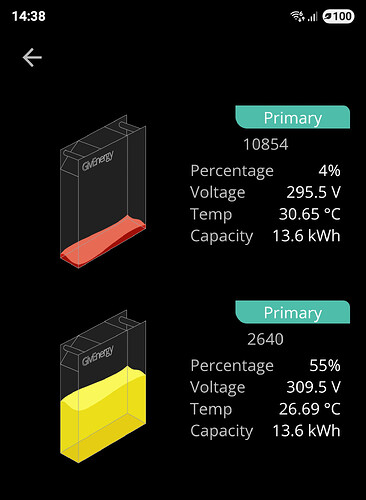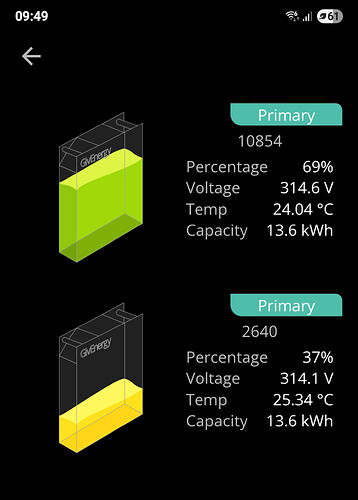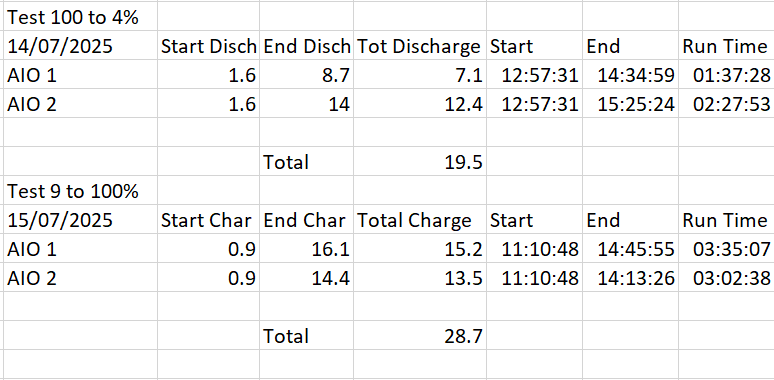Hi,
I have 1 AIO with Gateway as part of my Solar PV system. Been in a year and very happy with it. Been a rather protracted process to establish if I can run two. Long story - combo of DNO limitations on export and debates between GE and installer.
Anyway wondered if anyone here has a 2 AIO system and would be keen to get any feedback on performance and also any pointers / things to be aware of.
Regards,
Chris.
I have 2 AIO’s with Gateway and EV charger Installed in April this year has been nothing but trouble. I spend most of my waking day updating support tickets with the results of the latest test results.
EV charger is not supported for dual AIO’s at the moment unless you are happy for the charge to be taken from the AIO batteries.
My main issues are SOC between AIO’s and capacity issues on a full discharge getting just 20kWh out of a 27.16kWh dual AIO
I so wish I had not purchased the system mines more trouble than its worth.
I had my second AIO installed in Feb. I don’t have a GE EV charger, but do have a zappi as part of my house load. I am a GivTCP/Predbat user.
Generally, the AIO2 has been ok. The Gateway does a good job of balancing the charge/load between the two units so they don’t get too far out of whack. The GE iOS app and much of the web infrastructure still does not support more than one AIO. But GivTP and Predbat work well (and I use the latter to ensure my batteries don’t discharge to my EV). I am getting the full capacity out of the batteries.
The biggest issue I have is a failure to cope with grid outages - they still cause trips in spite of me forking out for a whole new CU and as part of the installation a complete electrical test. My installer has stopped responding to me, so I am rather stuffed.
The economics of a second battery are not great. But I guess you already know that.
So what discharge are you getting from your AIO’s ?
I managed 19.5kWh yesterday on a 100% to 4% discharge @ my DNO limited 9.5kWH. The recharge amount back to 100% was 28.5kWh
9kWh cannot just vanish. Either the measurements are wrong or you have a big puddle of electrons at the bottom of your AIOs. 
I measure charge/discharge using GivTCP, specifically the entities called “GivTCP-GW Energy Battery Charge Energy Today kWh” and “GivTCP-GW Energy Battery Discharge Energy Today kWh”. Taking yesterday as a random example at 17:00 the combined SoC (average across two AIOs) was 98% and by 23:30 it was 6% (so 92% discharged). During that period the Discharge sensor shows a total power out of the batteries of 25.8kWh (and there was no charge during that period). This implies 100% of the batteries equate to approx 28kWh.
Couple of caveats
- why is this more than the theoretical capacity (27.2kWh)? Probably because (1) the SoC reported is very approximate and (2) the actual battery capacity is higher than the 13.6kWh reported.
- who knows whether the Charge/Discharge numbers are very accurate? I certainly would not trust the GivEnergy app reporting for multiple AIOs right now.
Honestly, I think your bigger problem is the HUGE difference between SoC levels showing on your screen grabs. I have never seen anything of that magnitude - for me usually it’s 1-2% max, the highest I have ever seen is something like 5-7%. In your shoes that is what I would be raising with Support.
I have more screen grabs than you would believe. The discharge / recharge test I was talking about was a test for support. Up until that test it was AIO 2 that was always collapsing when the SOC got anywhere near 50%. During the current test it was AIO1 that collapsed rather than AIO2. here is an example of AIO 2 out of wack.
check out the spreadsheet of the test results.
The AIO2 - 12.4kWH discharge and 13.5 recharge looks about right. But the AIO1 8.7kWH discharge and 15.2 recharge is definitely suspect.
Support have upgraded me to V13 Gateway software and BMS 13 A0.618 on the AIO’s
I am beginning to wonder since both AIO’s have now collapsed to zero at different times, whether it is the Gateway that is at fault? The problem is that no one is in a rush to fix it, my system was installed in March and has never worked correctly.
I hear what you are saying about the missing kWH’s whenever my system SOC collapses I never get more than 19kWh out but it always takes nearly 30kWh to charge it up again, and when you are paying for this from the Grid it is an expensive business.


